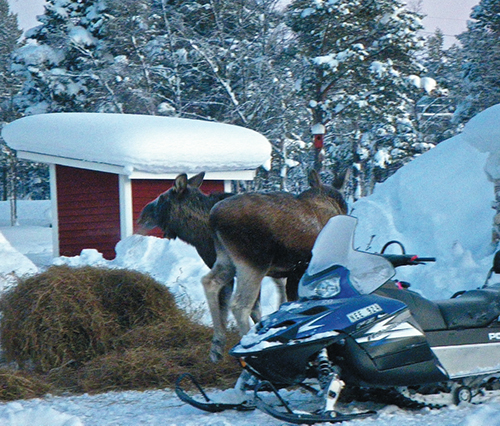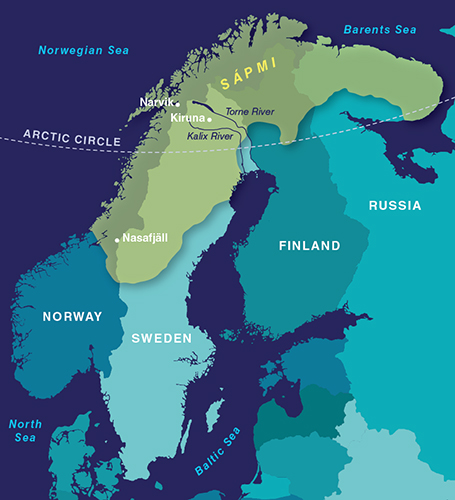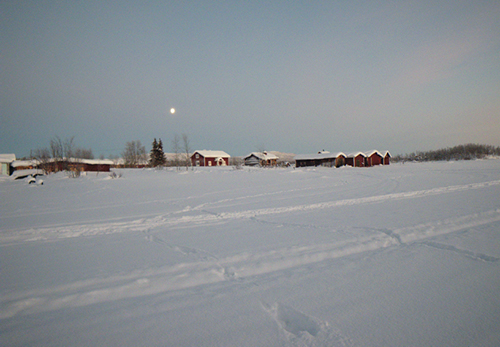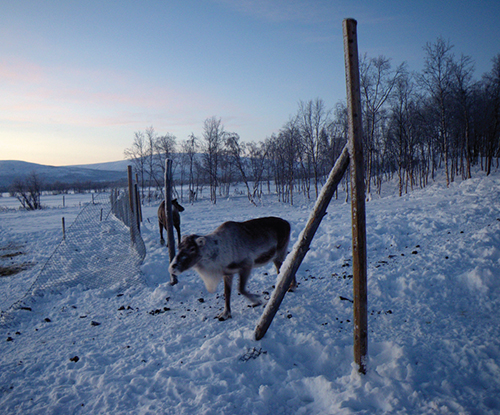Mining the Boreal North
By Nancy Langston
Resource extraction decisions are not simply about wilderness preservation or development.
Resource extraction decisions are not simply about wilderness preservation or development.

DOI: 10.1511/2013.101.98
A few days after Christmas, I took the train south from Kiruna, a small mining town 200 kilometers above the Arctic Circle in Sweden. All three train cars were filled with Asian tourists drawn to Kiruna by the promises of shiny brochures: “See the Aurora Borealis in the last pristine wilderness in Europe! Come to Sweden’s pure nature!”
I stood at the window and watched the taiga—the boreal forest—slip by through the polar night. The moon rose over stunted spruce and birch trees bent beneath drifts of snow. From inside the warmth of the train, you could imagine the land outside as the frozen Arctic wilderness pictured in the tourist brochures, protected from human influence by bitter cold and distance.

Photograph by the author.
But my partner and I had just spent the week with Sámi hosts on a farm in Puoltsa, a village 27 kilometers from Kiruna along the Kalix River. Even though daytime temperatures rarely rose above –36 degrees Celsius, the landscape that looked so silent from the train buzzed with activity. Wood had to be chopped, guests had to be fetched, reindeer and horses had to be fed supplemental hay, snowmobiles had to be tinkered with. The taiga is anything but pristine wilderness: It is an inhabited landscape where the indigenous Sámi and their reindeer have lived ever since the ice retreated 10,000 years ago. Yet the wilderness perception persists, particularly now when a tourist boom makes it profitable.
Why does a flawed idea of wilderness matter? It renders invisible the Sámi, indigenous people who have lived in what they call Sápmi—northern Norway, Sweden, Finland and the Kola Peninsula of Russia—since the retreat of the glaciers.

Illustration by Barbara Aulicino.
For centuries, urban governments have used the idea of the taiga as uninhabited and remote to promote colonization of the north for its resources. Open-pit iron mines proposed for Sámi territory in the ore-rich landscape near Kiruna, Sweden, continue to be justified by similar logic. The Kiruna region contains the largest underground iron ore mine in the world; 90 percent of all iron ore mined in Europe comes from here. From the Swedish government’s perspective, mining is inevitable because the world needs iron ore for steel, and the government needs mining profits to fund the social programs integral to Swedish society. But from the Sámi perspective, the proposed mines would make it impossible to continue reindeer herding, ending thousands of years of successful cultural adaptation to the taiga.
As the inland ice retreated from Sápmi some 10,000 years ago, reindeer (Rangifer tarandus) followed the edge of the ice as it retreated northward, and the ancestors of the Sámi people came with them. The anthropologist Piers Vitebsky has argued that without reindeer, human cultures could not have thrived in the boreal forest. Without people, reindeer might not have thrived as well.

Photograph by the author.
Reindeer are well suited to the taiga’s frigid winters. They can maintain a thermogradient between body core and the environment of up to 100 degrees, in part because of insulation provided by their fur, and in part because of counter-current vascular heat exchange systems in their legs and nasal passages. Cold is little problem; the challenge is finding food. Reindeer migration patterns reduce some, but not all, of their vulnerability to food scarcity.
Sámi herders do not just follow the reindeer. They have negotiated complex relationships with the animals, basing an eight-season migration pattern on the reindeer’s seasonal cycles. From March until April, the pregnant female reindeer began to move out of lowland forests toward mountain pastures. In April to May, calves are born, and the cows choose spring pastures where snow melts early, allowing them to supplement their lichen diet with leaves, grass and herbs. In June, reindeer select riparian vegetation near marshes and brooks, allowing them to quickly regain weight lost during the long winter. From June to July, when parasitic flies become a problem in the lowlands, reindeer move up into high, windy mountain meadows where they can find relief from both insects and heat. When August comes, reindeer build up fat and muscle to prepare for the winter and begin their migration to lower pastures, where the rutting period commences. During the rut, cows continue to accumulate reserves for the winter, while the bulls use much of their stored body fat and muscle weight, which they need to replenish during the brief autumn season. When the snows deepen in early winter, the reindeer migrate back toward lowland forests where they can dig through the snow cover to reach their main winter food source: ground lichens. From December through March, the coldest season, reindeer graze for lichens and berry plants in the coniferous forests. These migration patterns paid little attention to national borders; to find the best forage, reindeer often crossed from summer pastures in Norway into Sweden and Finland winter territories.
Originally hunters of reindeer rather than herders, the Sámi shifted to herding semi-domesticated reindeer after European incursions into their lands reduced their subsistence resources. In the 9th century, Norse chieftains moved onto Sámi lands and began taxing the Sámi. Records from a chieftain called Ottar, who was in the employ of King Alfred the Great of England, give some sense of the annual taxes demanded from the Sámi: “A man of the highest rank has to contribute the skins of fifteen martens and five reindeer and one bear and forty bushels of feathers and a tunic made of bearskin or otterskin and two ships’ cables … made either of whaleskin or of sealskin.” Kevin Crossley-Holland also notes that Ottar mentioned that the Sámi had trained reindeer as decoys to bring the wild herds closer for easier hunting, suggesting that a shift in subsistence practices from hunting to herding reindeer had already begun.
Trappers and traders came to Sápmi to capitalize on the growing European market for furs, selling firearms to the Sámi. The Sámi intensified hunting, depleting the boreal forests of fur-bearing animals and reindeer. As subsistence resources dwindled, the Sámi began to domesticate wild reindeer, and by the 17th century, herding of semi-domesticated reindeer had largely replaced hunting of wild reindeer.
The north, in European eyes, seemed empty of people (even though the Sámi provided essential taxes), and that emptiness justified it becoming Sweden’s colony for resource extraction—first for furs, then for minerals, timber and energy. In 1542, the Swedish king Gustav Vasa proclaimed that “all permanently uninhabited land belongs to God, Us and the Swedish Crown, and nobody else.” In 1635, cabinet minister Carl Bonde wrote to the Swedish statesman Axel Oxenstierna describing silver ore deposits in the north, expressing his belief that the boreal north could become Sweden’s own West Indies. The year before, a Sámi man named Peder Olofsson had mentioned to some Swedes that he had found silver ore in Nasafjäll in Pite Lappmark, close to the Norwegian border. Silver revenues might help fund war expenses that burdened the Swedish state, so in 1635, mining began at the Nasafjäll works.
Transport of ore to smelters and then to markets was vital for mining development. The Swedes believed that the Sámi were too weak and lazy to dig ore but were useful for transporting that ore. Sámi were ordered to use their reindeer to carry ore 60 kilometers between the Nasafjäll mine and the smelting works. The Sámi refused, fearing the work would interfere with reindeer herding cycles. Swedish workers described how they forced the Sámi to comply: “We tied them to a couple of timbers, pushed them down into the rapids a few times and then pulled them up to allow the water to run out of their mouths again, so all the people working in the mine were aware of the situation.” Contemporary accounts speak of the road “lined with bleached reindeer skeletons long after mining finished.” Many Sámi refused what they saw as enslavement and instead fled to Norway, even though the Swedish government sent troops to prevent their escape. Much of their territory near the mine became depopulated.
In 1673, the Swedish king encouraged Swedish citizens from the south to move north and colonize the Sámi area. Few Swedes, however, were interested in moving to a place they saw as remote, barren and inhospitable, even when the king promised relief from military service and taxation. The Swedes who moved into the forest found settled farming nearly impossible in the harsh climate, so they began hunting and fishing on Sámi lands and cutting hay in winter reindeer pastures. The Sámi herding territories and fishing grounds were squeezed by the new immigrants, but when conflicts arose, the Sámis were able to assert their communal property rights in Swedish courts.
With 19th century industrialism, colonial development of the north’s resources exploded, transforming Sámi relations with reindeer and territory once again. Although a series of earlier court decisions had affirmed Sámi property rights, the Swedish state now saw Sámi communal land ownership as an obstacle to exploitation of boreal resources. To justify stripping the Sámi of their property rights, the Swedish government turned to the contemporary science of racial difference. Eugenicists and social Darwinists argued that the Sámi were an inferior race, unable to make adult decisions, so the Swedes would have to decide what would happen on Sámi lands. Swedish policy toward the Sámi was defended with a racist ideology that claimed to have found “scientific verification” of Darwin’s theory of natural selection and the survival of the fittest within the human community.
In 1886, Sweden passed the Reindeer Husbandry Act, which reduced Sámi ownership of land and water to mere usufruct rights. The Sámi could no longer own the land; they only retained limited rights to graze, fish and hunt. Those Sámi who did not herd reindeer and instead made their living primarily from fishing lost their land and forest use rights. Only Sámi who met certain ideas of traditional reindeer culture were protected, and only if they remained frozen within static notions of primitiveness.
Sámi communities had traditionally organized themselves along the principle of the siida , which were both territories and governance structures. Rather than individual land ownership, each siida managed its own territory for hunting and fishing. As reindeer migration and herding patterns changed, siida boundaries changed as well. Groups of siidas formed a single Sámi village or samebyar . Individual families owned reindeer, but the complex governance rules within Sámi villages managed pastures and migration routes cooperatively. This was not an open-access commons system; it was a carefully regulated land tenure system that prevented overgrazing in most circumstances. However, like many other traditional land tenure systems, it was vulnerable to political decisions about property that were imposed from outside the region.
In the 1920s, an agreement between the Norwegian and Swedish governments prevented the Sámi in Sweden from grazing their herds over the border into Norway. This, along with mining and timber projects, reduced the pastures available for the Sámi, and overgrazing resulted. The Swedish state believed that overgrazing resulted from the traditional land tenure systems (a “tragedy of the commons”), rather than from undermining those traditional land tenure systems by state policy decisions. The Swedes decided that they needed to rationalize Sámi grazing and ordered massive reduction of herds and herders.
As Sámi lost their property rights, timber harvests increased across Sápmi, further reducing grazing habitat for reindeer. Clear-cutting removed nearly all the older spruce forest, critical habitat for the pendulous lichen that forms important winter food for the reindeer. Modern forestry involved plowing, drainage and soil scarification, which reduced the ground-growing lichens that sustained reindeer during fall and spring. A series of court cases in the 1990s, when forest companies argued that reindeer were damaging replanted trees, further undermined the rights of Sámi to graze their herds in traditional winter forest pastures.
Hydropower development also transformed riparian and aquatic communities across Sápmi. In the 1950s and ‘60s, Sweden turned to intensive hydroelectric development to fuel modernization of the Swedish postwar society. The government envisioned a system whereby each river that fell to the Baltic would be dammed, the power of the flow fully utilized for the nation’s industrial development. The state formed a hydroelectric company, Vattenfall, which set out to rationalize the river systems of the north. Between 1957 and 1961, Vattenfall turned to the Kalix and Torne river system in Sápmi. In what would have been the largest hydro project in Swedish history, the Atlantprojekt, Vattenfall proposed reversing the flow of the rivers, so they would fall westward to the Atlantic Ocean instead of eastward to the Baltic. With an intricate systems of dams, canals and tunnels, half the flow of the rivers would have been diverted into Norway to power an enormous hydroplant. Commercial fishing interests and Sámi reindeer herding villages organized, halting the project. Because of this intervention, the Kalix and Torne river system is one of only four unregulated large rivers remaining in Sweden.
Swedes had long suspected that the north contained some of the richest iron ore deposits in the world, but exploitation could not begin until the transportation problem was solved. In 1903, Sweden completed a railroad running from the Baltic port of Luleå, through the iron ore region of Kiruna, then down to the ice-free port of Narvik on the Norwegian coast. The mining boom at Kiruna was on.
Initially open-pit mines, the Kiruna mines transformed the landscape. Historic photos show that mountaintops were removed to reach the rich ore deposits, a precursor to today’s controversial mountain top removal in Appalachia. The work was dangerous, and pollution from the pit and tailings piles was notorious. Sulfates contributed to acidification both of local watersheds and larger regional watersheds. Acids leached toxic heavy metals from rocks where they had been safely locked up, into river systems where they contaminated food chains that eventually included people. Smoke from smelters contained heavy metals such as cadmium and lead, which were captured by lichen and then accumulated in reindeer and the people who ate them. Mine tailings were stacked in enormous terraces, and winds blew toxic dust over reindeer pastures. Sediments washed over spawning beds for anadromous fish.
In the 1960s, the Kiruna mines moved underground, safety records improved, and treatment facilities reduced emissions. Yet the toxic legacies persist. Today, according to Per-Ola Hoffsten and colleagues, “wastes from the Kiruna mine … [continue to] drain into the Kalix River. Mercury pollution causes problems locally in Lake Ala Lombolo in the Kiruna area that drains into the Torne River at Jukkasjarvi via Luossajoki stream. The impacts stem from previous pollution and still causes reduced invertebrate diversity and deformed mouthparts in larval midges living here.”
Global markets affect local conditions in Sápmi, remote as the region seems to many people. A global steel boom in recent years has increased Asian demand for iron, and LKAB (the Swedish-owned mining company that operates the Kiruna iron mine) has decided to expand the mine, which means Kiruna’s city center must be moved, an enormous logistical undertaking.
Local communities accept the need to move Kiruna, but new open-pit mining proposals in the Kalix River valley have met with more opposition. In 2010, an Australian mining company named Kiruna Iron proposed to create three new open-pit mines in the Kalix River valley. These mines would operate for 10 to 20 years, depending on steel prices; Sweden would agree to collect no royalties or taxes on the profits. The Swedish government approved the proposal, ignoring the fact that the proposed mines lie in the heart of two Sámi reindeer villages.

Photograph by the author.
The Sámi argued that the proposed mines would alter ecological relationships within their territories, making it impossible for reindeer herding to persist. The mines, for example, would likely consume 60 to 70 percent of the spring pasture area and substantial portions of fall pasture. Mining infrastructure would block critical migration routes, and dust from tailing piles would change succession patterns in spring pastures, allowing grass to overtake ground lichen. Autumn pastures would also be reduced, increasing reindeer vulnerability to harsh winter conditions. From the Sámi perspective, “how can 20 years of mining take priority over thousands of years of Sámi culture?”
The Swedish government contends that the Sámi have no rights to exclude competing uses from Sámi territories. From their perspective, industrial development is inevitable and the Sámi must make way for it. If the good ore happens to interrupt a migration route, then move the reindeer somewhere else. Put them in trucks if necessary. If tailings piles eliminate lichen, then feed the reindeer something else. In this view, domesticated reindeer are essentially cogs in a machine, not members of interconnected ecological systems. The logic assumes that sharp boundaries exist between wild and tamed nature. But reindeer disrupt these boundaries, for they are semi-domesticated creatures. The migration paths they choose are negotiations with the reindeer herders, not engineered decisions imposed by technical logic. The food they eat is neither purely natural nor domestic, and the pastures they need cannot simply be replaced.
Environmental history cannot tell us whether mining in a particular place should happen—that is a social decision, not a scientific or historical decision. But historical perspectives can remind us that there is nothing natural or inevitable about resource development. Resources are contingent and they change over time. Calling something a resource pulls it out of its intricate social and ecological relationships and isolates it in our gaze. Yet those isolations are illusions. We still live in intimate relationships with larger landscapes, even if we think technology isolates us from ecological constraints. When minerals are dug from the ground, when trees are cut in the forest, when flood waters are diverted, when rivers are dammed, when animals are changed from fellow creatures to livestock resources, we set into motion subtle processes of toxic transformation that have legacies far into the future.
Urban rulers long envisioned the north as a remote hinterland best suited for resource extraction. Yet what environmental history can reveal are the ways that the north is intimately connected to sites of industrial activity by animal migrations, by atmospheric currents, by historic legacies. Mining conflicts in the north are not about preserving wilderness or developing it. Rather, they revolve around what kinds of relationships to natural communities will be supported—and who has the right to decide.
Click "American Scientist" to access home page
American Scientist Comments and Discussion
To discuss our articles or comment on them, please share them and tag American Scientist on social media platforms. Here are links to our profiles on Twitter, Facebook, and LinkedIn.
If we re-share your post, we will moderate comments/discussion following our comments policy.